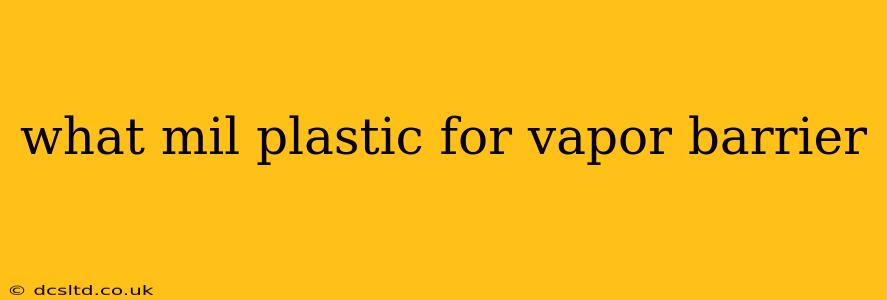Choosing the right mil plastic for a vapor barrier is crucial for protecting your home or building from moisture damage. The "mil" refers to the thickness of the plastic sheeting, and selecting the appropriate thickness depends on several factors, including the application, climate, and building materials. This guide will help you understand the different mil options and choose the best one for your needs.
What Does "Mil" Mean in Plastic Sheeting?
"Mil" is a unit of measurement equal to one-thousandth of an inch (0.001 inches). When you see a plastic sheeting described as 6 mil, for example, it means the plastic is 0.006 inches thick. Thicker mil plastic generally offers greater durability and better vapor resistance.
Common Mil Thicknesses for Vapor Barriers and Their Applications
While there's no single "best" mil thickness for all vapor barrier applications, here's a breakdown of common options and their typical uses:
6 mil plastic: This is a relatively thin plastic sheeting often used for temporary applications or in less demanding situations. It might be suitable for protecting materials during construction but is generally not recommended as a long-term vapor barrier in walls or roofs. It offers minimal protection against tearing and punctures.
10 mil plastic: A more robust option than 6 mil, 10 mil plastic sheeting provides better tear resistance and more reliable vapor barrier protection. It's frequently used for ground covers, under concrete slabs, or as a temporary barrier during construction. It provides a decent level of protection but may still be susceptible to damage over time.
What Mil Plastic is Best for a Vapor Barrier?
The ideal mil thickness depends heavily on the specific application. For long-term, critical vapor barrier applications, such as within a wall assembly or under a roof, it's generally recommended to use a thicker, more robust material specifically designed as a vapor barrier, rather than relying solely on polyethylene sheeting.
These specialized vapor barriers often incorporate features like UV resistance and superior puncture resistance, exceeding the capabilities of simple polyethylene sheeting. They are available in various forms and may not be labeled by mil thickness, instead focusing on performance metrics like permeance ratings. Consult with a building professional for guidance on appropriate materials for your specific climate and construction type.
What is the Difference Between a Vapor Barrier and a Vapor Retarder?
This is a crucial distinction! A vapor barrier aims to completely prevent moisture vapor from passing through, while a vapor retarder slows down the passage of moisture vapor. The choice depends on the climate and building design. In humid climates, a vapor retarder placed on the warm side of the insulation can be more effective than a complete vapor barrier.
What are the Alternatives to Plastic Sheeting for Vapor Barriers?
While plastic sheeting can be used, particularly in less demanding applications, there are more effective and long-lasting alternatives specifically engineered as vapor barriers, including:
- Polypropylene Films: These offer improved strength and tear resistance compared to polyethylene.
- Housewraps: Designed for exterior wall applications, these offer both vapor protection and weather resistance.
- Specialized Membranes: Advanced membranes offer excellent vapor control along with other desirable properties.
Is it Necessary to Overlap Plastic Sheeting When Installing a Vapor Barrier?
Yes, absolutely! Overlapping seams are crucial to prevent gaps that can compromise the vapor barrier's effectiveness. Overlaps should typically be a minimum of 6 inches and sealed with appropriate tape designed for this purpose.
How Long Does Plastic Sheeting Last as a Vapor Barrier?
The longevity of plastic sheeting as a vapor barrier depends heavily on the mil thickness, environmental conditions, and potential damage. Thicker sheeting naturally lasts longer. However, for critical applications, specifically designed vapor barrier materials are recommended for long-term reliability and performance.
In summary, while various mil thicknesses of plastic sheeting can serve as temporary or less demanding vapor barriers, consulting with a building professional to determine the best material for your specific project is always recommended. Choosing a dedicated vapor barrier or retarder designed for the application provides superior long-term protection and peace of mind.
